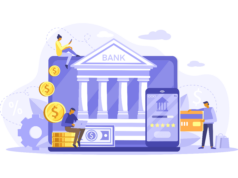In an era of unprecedented technological innovation, businesses that are receptive to change tend to gain a competitive advantage. Such companies will always be able to meet consumer needs a lot faster than their stubborn counterparts.
For example, many companies are currently moving from corporate performance management to more unified management platforms. With the help of some of the best innovators like Holland Parker among others, modern financial management techniques have proven to be one of the differences between a struggling and a successful business today.
The inevitability of change warrants a unique approach to how businesses function in the modern age. The ubiquity of e-commerce websites all vying for their piece of the pie necessitates out-of-the-box thinking for businesses that want to rise above the competition. With so many e-commerce operations doing things the same way, it takes something special to capture visitors’ attention.
Nowadays, online shopping for goods and services is increasing at a steady clip and has really gained popularity among customers. Since the pandemic hit, businesses that were slow to adopt had to close down or take huge losses. On the other hand, there are those that embraced change and began home deliveries even if it meant extra costs on their part. Today, companies that continue to reap fruits are those that were ready to try something new in the middle of the pandemic.
Work, education, delivery services, consultation services mostly, and even medical services are being performed online. Lower levels of person-to-person communication, interaction, and connectivity have transformed the way society functions, more so during the pandemic. Businesses looking to maximize their profits tend to be well served by adopting smart technology to stay ahead of the pack. For some, this means implementing back-end operations such as enhanced search functionality so that visitors can easily find what they’re looking for. The relevancy of search results is sacrosanct.
If clickable links are broken, or there are missing pages, or the content is poorly constructed, there is no sale because the potential customer will be frustrated and forced to move to your competitors. It might not seem like a big deal to you because you’ll still be able to make a few sales, but it damages your reputation in the long run. Not to mention, even your most loyal customers would be forced to favor a competitor for the sake of efficiency and convenience.
The Conversion Funnel for e-Commerce Platforms

Feature-rich websites are one thing, but they are insufficient to entice visitors to browse, add products or services to their shopping cart, and complete purchases online. The conversion funnel is filled with steps and stages, each of which is vital to successfully get a visitor from Point A to Point B. The 4 stages include Awareness, Interest, Desire, and Action (AIDA). Nothing upsets a business owner more than a high bounce rate on a website—the higher the bounce rate, the lower the stickiness.
Studies show that shoppers prefer automated self-help options as opposed to waiting online for a live chat agent to help them with questions, queries, and complaints. Each step of the process should be carefully constructed to begin converting leads into actual customers. The pathway to a successful sale is riddled with incredible complexity. The most successful businesses understand this problem, and they work diligently to meet the needs of customers time and again.
Of course, conversion funnels are of little value if the website is not optimized for peak performance. There are many bugbears that visitors face daily when they search for products and services online. Most everyone now has a low tolerance for websites that don’t work well. If website pages take too long to load, the visitor will go elsewhere and make a purchase.

If clickable links are broken, or there are missing pages, or the content is poorly constructed, there is no sale. Today’s e-commerce shopper is ‘cyber street smart.’ The Internet is the modern-day stomping ground for anything and everything that a person could want. It is a global shopping village, a universe of entertainment, and a seemingly infinite well of knowledge for educational content, and opinions. It is also a hive of activity for ‘social media connectivity’, a novel way of staying connected without physically getting involved.
When a company decides to take its business online, it’s imperative that every conceivable aspect of the business website – the entire e-commerce platform – is working like a well-oiled machine. One of the most effective ways to mitigate a high bounce rate is a system known as a content delivery network. SMEs across the board are turning to professional CDN hosting services to benefit from increased user-friendliness, lower bounce rates, and enhanced revenue potential.
Of course, this naturally begs the question: What is a CDN hosting service? The answer is multifold but begins with a rudimentary understanding of online communications. Click here for more. Businesses that register for CDN hosting services typically have their content divided up and stored at many different servers globally. By reducing the latency time between clicking on a page, a link, or an action, businesses will benefit. When a visitor initiates an action, they expect to see a reaction. The quicker the action/reaction relationship, the better it is for both parties. This translates to more sales and visitors.

The problem with having an e-commerce platform at a server in one country, territory or jurisdiction is that the further away the visitor is, the longer it takes for that website to load. This isn’t good for business. CDN hosting services guarantee faster website loading times. Having multiple copies of the web site’s static content at different servers all over the world makes it easy to see how this divided approach can benefit customers in different geographic locales. This guarantees that businesses will remain competitive in the cutthroat e-commerce industry.
Other peripheral benefits that are equally important include enhanced security systems, protocols, and tools, courtesy of CDN hosting providers. From a cost perspective, CDN hosting services can also cut costs for businesses by reducing the bottleneck that accrues if a website is hammered with too much traffic. In such situations, websites can shut down, resulting in an unprecedented loss. Dissemination of static content on a website across multiple servers all over the world also reduces the need for excessive bandwidth – another cost-cutting mechanism.
Up-Sells and Cross-Sells of Products and Services

Other areas where businesses can maximize revenues and profits include the dual areas of up-sells and cross-sells. These approaches are built on the foundations of optimized search platforms. With artificial intelligence (AI) technology in place, it is possible to bolster sales by executing high-value upsells to customers.
The concept of cross-sells is equally important. Fast food restaurant franchisees built empires by way of cross-sells to their customers, but with e-commerce platforms, novel thinking is required. Once again, AI technology can play a significant part in driving up revenues and profits.
With respect to the conversion funnel alluded to earlier, stats show that a fraction of over 3% of visitors to a website will complete a transaction. With such a low conversion rate, it’s imperative that website functionality, website design, website accessibility, and website user friendliness work in concert with the overall revenue and profit maximization objectives.









